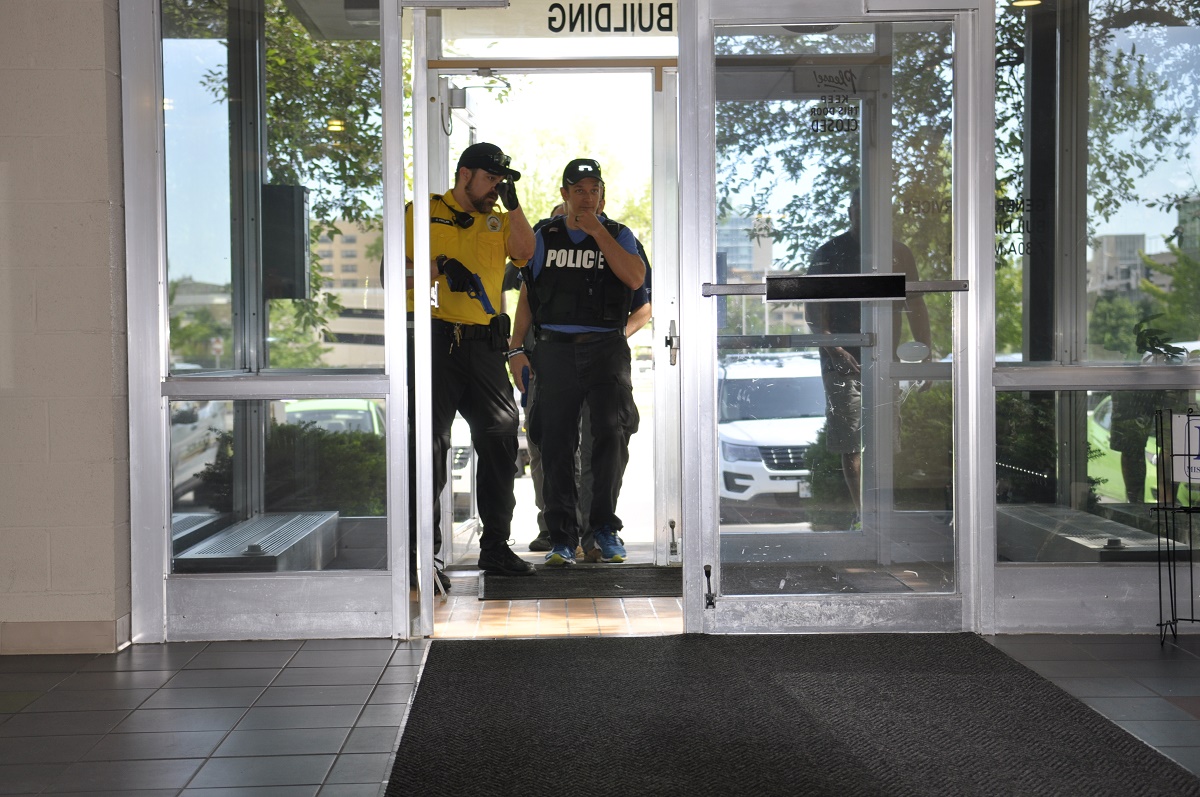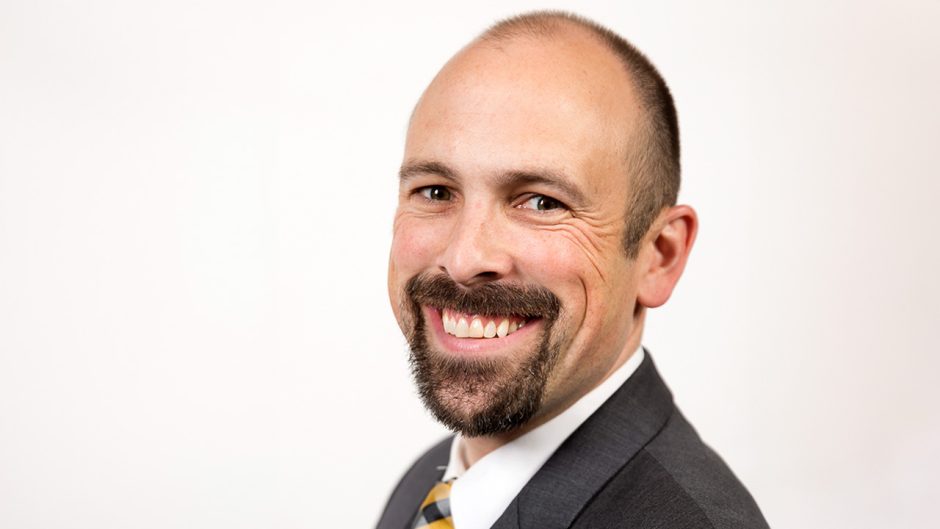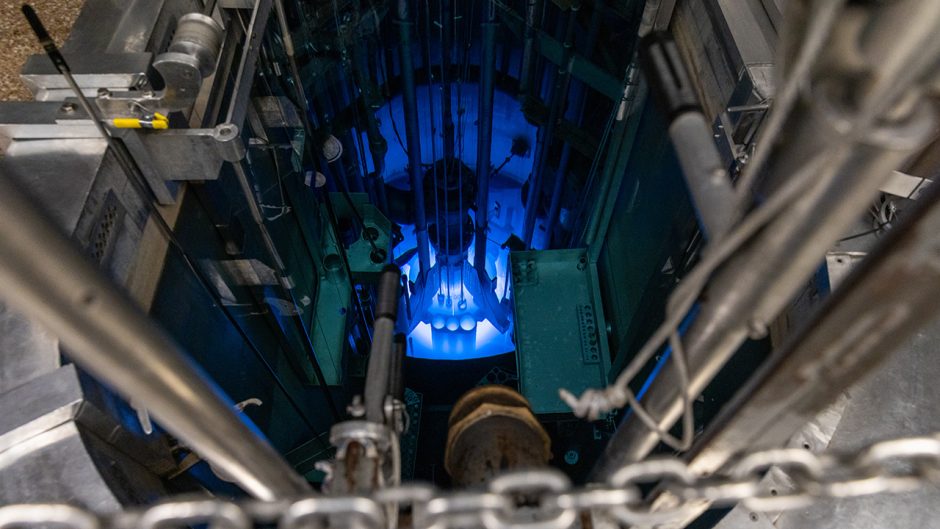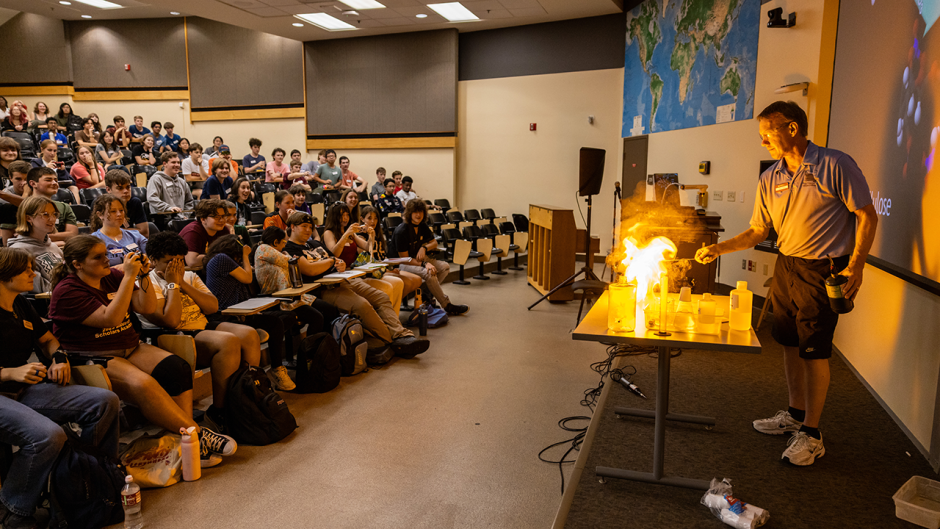On three consecutive Sundays in June, trios of officers with the University of Missouri Police Department — dressed in protective gear and armed with training weapons — moved through the General Service Building, sweeping hallways, offices and classrooms in search of a fictional intruder.

University of Missouri police officers Justin Patlan, left, and Dustin Heckmaster enter the General Service Building during a recent daylong active threat training on campus.
These officers were in training for a catastrophic event they hope to never encounter on campus: an active threat. Even though the events were practice, the tension was real.
“This training is an opportunity for our officers to enhance their skillsets and build confidence in their abilities,” said MUPD Sgt. Rodney Stewart, who coordinated the training exercises. “During the training, we stress the importance of communication, commitment and officers knowing their responsibilities.”
Ultimately, the goal is to teach officers how to respond quickly and stop the danger, whether it’s an active shooter, a barricaded subject or a hostage situation.
“It comes down to a simple equation: time equals lives saved,” Stewart said. “The faster officers can make entry into a location and confront the active threat, the fewer the casualties.”
The active threat training gives officers an opportunity to work with certified firearm instructors and practice together.
Stewart, who has been a firearms instructor since 2007 and an active shooter response instructor since 2008, said the idea is to make the training as realistic as possible, replicating the conditions and the stress officers would experience on what undoubtedly would be the worst day of their career.
Training began early at the General Service Building where officers divided into small groups and rotated through a series of stations designed to challenge them to work as a team while under an active threat. During this part of the training, officers used “blue guns,” which are blue plastic imitation weapons that have the weight and feel of the real thing.

Sgt. Rodney Stewart, a certified firearms and active shooter response instructor, watches as Officer Patlan trains to respond to an emergency call involving an active threat on campus.
The most recent shift in MUPD’s training involves “warm zone” operations, a relatively new emergency response strategy that involves law enforcement providing protective cover for emergency medical services personnel while they triage, treat and evacuate the wounded inside buildings not yet fully secured.
“The idea is to save more people,” said Sgt. Sergeant Alan Fish, who is an active shooter instructor. “Warm zone is the latest in emergency response.”
Officers also searched hallways and rooms individually, practicing tactics, such as a basic maneuver called “slicing the pie,” which is extremely useful for clearing rooms, hallways or rounding a corner. They were reminded to use their flashlights judiciously, “painting” a room with flashes of light instead of flooding an area with a constant beam.
“If you keep your flashlight on, it will let everyone know where you are,” warned Officer David Licklider, another firearms instructor at MUPD.
Officer Brian Frey, who is also a firearms instructor at MUPD, encouraged officers to be alert but comfortable while searching.
“Be careful how you hold your body as you’re searching because you can wear yourself out in an awkward position,” he said.
There was also a classroom portion of the training that included some warm zone operations instruction and an overview of how to use items inside each patrol car’s trauma medical kit.

Officer Haley Eisenberg listens as Officer Brian Frey, a certified firearms instructor, gives her feedback following a training exercise that involved searching hallways and classrooms for a violent intruder.
The training concluded with a series of “force-on-force” scenarios in which officers, armed with replica guns, were dispatched to another location on campus to confront a threatening situation, such as an active shooter or a barricaded subject. All total, the officers practiced six scenarios based on training earlier in the day. Volunteers from the community played a variety of roles from victims to assailants.
“Each of the scenarios is set up to allow the officers to use the principles and tactics that were practiced at the beginning of the day,” Stewart said. “But each scenario has a different teaching point.”
The training is one example of how MUPD officers keep their skills fresh and consistent with best practices. Sessions like June’s training contribute to MUPD’s accreditation through the Commission on Law Enforcement Accreditation and the International Association of Campus Law Enforcement Administrators.
Throughout the year, officers continue working with the department’s firearms and active shooter instructors to hone their skills and prepare for an active threat, whatever it might be.
“The bottom line is we’re here to save lives,” Stewart said.


![062625_CEI Aerial View_email-cropped[29] (1)](https://showme.missouri.edu/wp-content/uploads/2025/06/062625_CEI-Aerial-View_email-cropped29-1-940x529.jpg)

